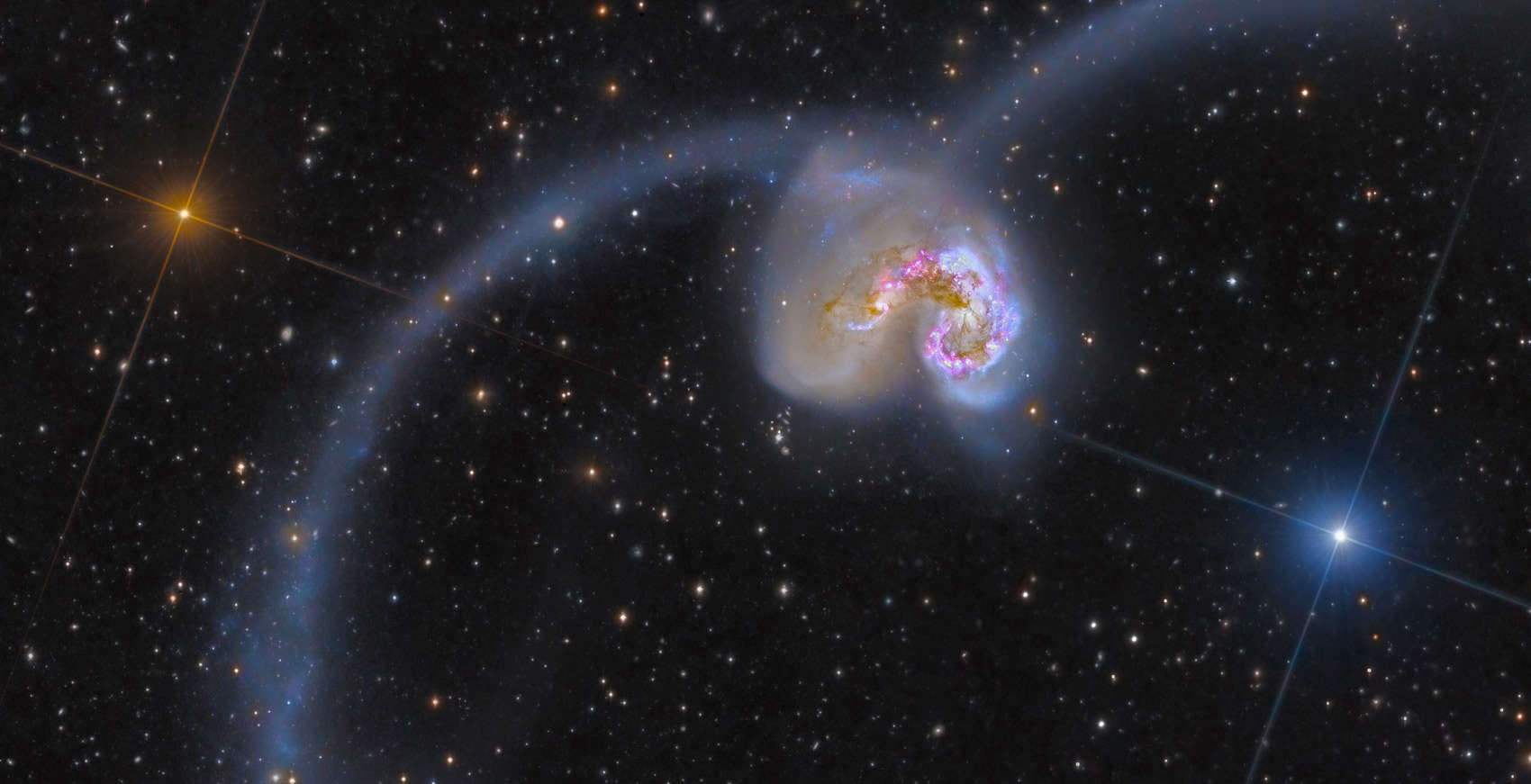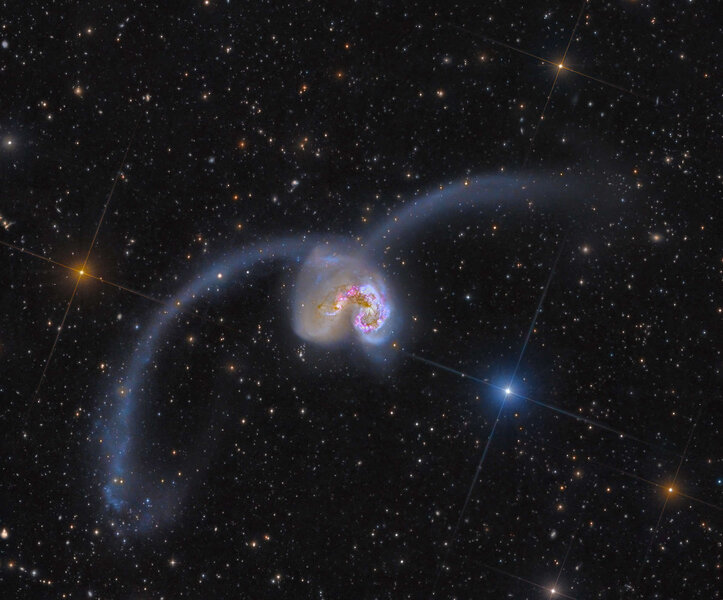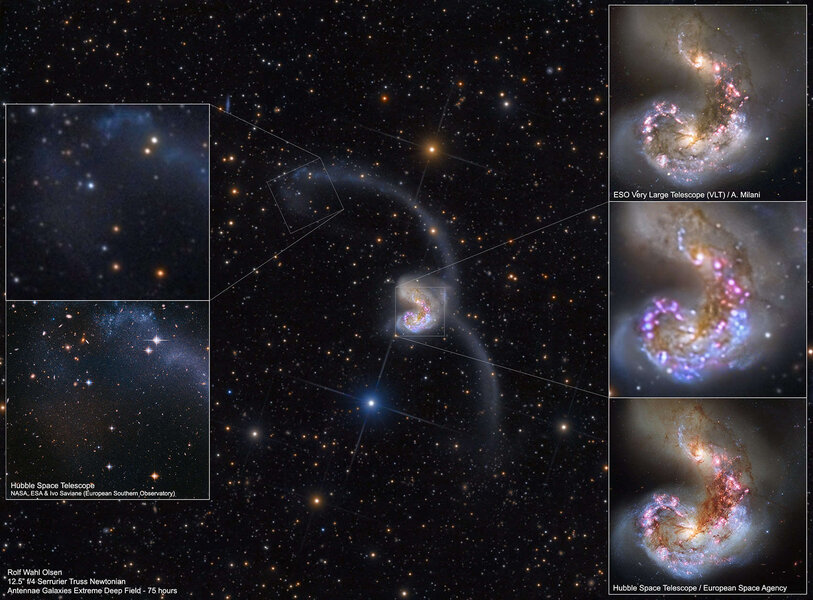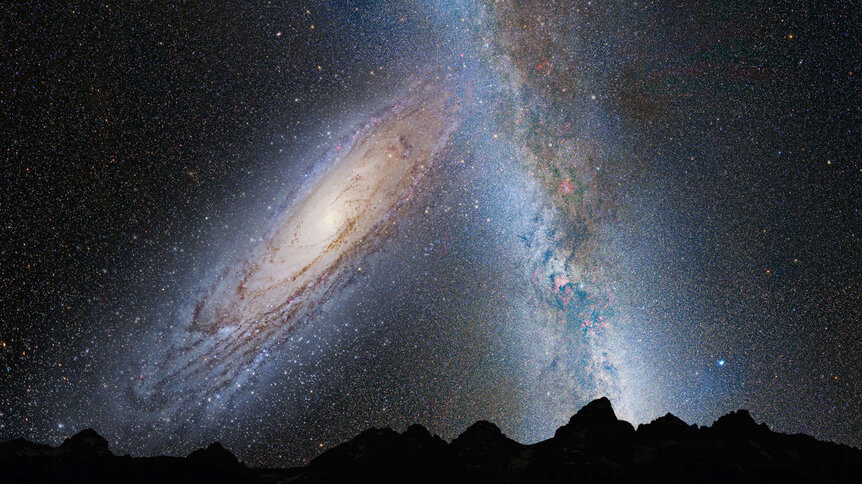Create a free profile to get unlimited access to exclusive videos, sweepstakes, and more!
Going deep on colliding galaxies

It's hard to imagine a bigger catastrophe than colliding galaxies.
Picture it: Two behemoths, each a hundred thousand light years across and with hundreds of billions of stars, approaching each other at hundreds of kilometers per second. Even before the actual collision the destruction is wreaked on a colossal scale, the gravity of each distorting and stretching the other like taffy, flinging away stars in long, sweeping arcs sometimes far larger than the galaxies themselves.
Then the actual collision. Sometimes the galaxies pass through each other, but their gravity pulls them back together, and, after hundreds of millions of years of chaos and turbulence, they merge into a single, larger galaxy.
Of course, a picture is worth 1k words:
[Note: I had to shrink the image to fit the blog; the highest-resolution (3800 x 3200 pixel) image is a jaw-dropper.]
That is NGC 4038 and 4039, a pair of galaxies caught mid-collision. They are also called the Antennae Galaxies due to their resemblance of insect antennae, though I've always thought they look more like a bird flying directly away.
That amazing image is the work of astrophotographers Rolf Olsen in New Zealand and Federico Pelliccia in Italy. It combines three separate datasets from the massive 8.2-meter Subaru telescope, the Hubble Space Telescope, and Olsen's own telescope… a 30-centimeter 'scope he built himself! All three images were painstakingly processed and blended together; the background and long arc are from Olsen's 'scope and Subaru, while the detail in the center is from the iconic Hubble image. Olsen says this is the deepest and highest resolution image covering the entirety of the galaxies.
The Hubble images used were probably not very long exposures — the galaxies are fairly bright and Hubble can go deep quickly — so maybe a couple of hours total. The Subaru images used totaled a mere 100 minutes. Olsen's own exposures were a tad longer: a total of 75 hours. The dedication here is astounding.
The galaxies were once thought to be about 65 million light years away, but different Hubble images were examined by scientists, and by measuring the brightest red giant stars a closer distance of just 45 million light years was found.
The two galaxies probably started their long dance about a billion years ago, when they first started approaching each other. They made a pass, flying past each other, and during that encounter the long arcs of stars were formed. These are called tidal tails, the outcome of both gravity and angular momentum. The streamers were drawn out by gravity: As they approached, the near side of each galaxy felt the gravity of the other more strongly than their respective far sides. This stretched the galaxies, pulling stars out of the outer reaches.
That first collision was a near miss; they passed very close but did not collide head-on. This swung them around each other, and the curving path affected the tails, bending them. Gas clouds pulled out along the arc collapsed to form stars, some of which are massive, hot, and blue, and their light dominates the tails.
But the core… both of the galaxies were spirals before the collision, and laden with gas clouds. As they fell together, the inner spiral regions slammed together, colliding those gas clouds, and the ensuing star formation was more an explosion than a steady process. We call such event starbursts, and the name is apt. The chaos in the center is palpable, with pink gas clouds glowing from the light of their newborn stars, huge filaments of dust clouds silhouetted against them. You can still see the original spiral pattern, but it's ephemeral; gravity will win as it always must, and eventually as the merger continues that pattern will be lost.
We learn a lot about the behavior of galaxies as they collide. Do they always blast out star formation? How long are the tidal tails, and does that depend on the galaxies themselves? What happens if the galaxies manage to pull themselves apart and not merge? How damaged will they be then?
These aren't entirely academic questions. In 4.6 billion years the mighty Andromeda Galaxy, every bit the equal of our Milky Way, will collide with us. Predictions abound, but the resemblance to the Antennae Galaxies will be strong, right down to a first close pass.
Interestingly this will happen well before the Sun turns into a red giant and begins its long death, and the Earth itself will likely still orbit it. What will be our fate? Tossed out of the impact like those tails? Dropped to the center where chaos rules? Or will we still maintain our orbit pretty much as it is now, inside the merged final galaxy? It's not clear, though by that time the gradual heating of the Sun as it ages means the Earth will be a scorched ball by then.
If humanity is still around — on another planet orbiting a different star, hopefully — what a site that will be! Oh, I'd love to see it… but Olsen's image of the Antennae Galaxies will have to suffice until then.

















